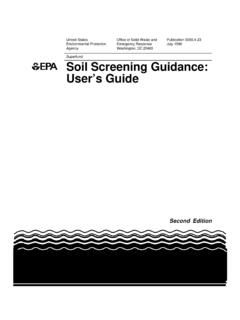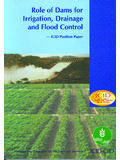Transcription of STREAM RESTORATION, A NATURAL CHANNEL DESIGN …
1 STREAM restoration Prep8 AICI by the North Carolina STREAM Restonltlon Institute and North Carolina Sea Grant *554360*. SDMS Doc ID 554360. INC STATE UNIVERSITY I. North Carolina State University and North Carolina A&T State University commit themselves to positive action to secure equal opportunity regardless of race, color, creed, national origin, religion, sex, age or disability. In addition, the two Universities welcome all persons without regard to sexual orientation. Contents Introduction to Fluvial Processes 1. STREAM Assessment and Survey Procedures 2. Rosgen STREAM -Classification Systems/. CHANNEL Assessment and Validation Procedures 3. Bankfull Verification and Gage Station Analyses 4. Priority Options for Restoring Incised Streams 5. Reference Reach Survey 6. DESIGN Procedures 7. Structures 8. Vegetation Stabilization and Riparian-Buffer Re-establishment 9.
2 Erosion and Sediment-Control Plan 10. Flood Studies 11. restoration Evaluation and Monitoring 12. References and Resources 13. Appendices Preface Streams and rivers serve many purposes, including water supply, The authors would like to thank the following people for reviewing wildlife habitat, energy generation, transportation and recreation. the document: A STREAM is a dynamic, complex system that includes not only Micky Clemmons the active CHANNEL but also the floodplain and the vegetation Rockie English, along its edges. A NATURAL STREAM system remains stable while Chris Estes transporting a wide range of flows and sediment produced in its Angela Jessup, watershed, maintaining a state of "dynamic equilibrium." When Joseph Mickey changes to the CHANNEL , floodplain, vegetation, flow or sediment David Penrose supply significantly affect this equilibrium, the STREAM may Todd St.
3 John become unstable and start adjusting toward a new equilibrium state. This transition may take a long time and cause big Funding for this guidebook was provided by: changes to water quality, habitat and adjacent property. Department of Environment and NATURAL Resources, STREAM restoration is the re-establishment of the general structure, EPA 319 Grant Program function and self-sustaining behavior of the STREAM system that Department of Transportation existed prior to disturbance. It is a holistic process that requires an understanding of all physical and biological components of the STREAM system and its watershed. restoration includes a broad range of measures, including the removal of the watershed disturbances that are causing STREAM instability; installation of structures and planting of vegetation to protect streambanks and provide habitat; and the reshaping or replacement of unstable North Carolina STREAM reaches into appropriately designed functional streams and associated floodplains.
4 This document promotes a NATURAL CHANNEL DESIGN approach to STREAM restoration . It is intended primarily as a reference for NATURAL resource professionals who plan, DESIGN , review and implement STREAM - restoration projects. This document is not a substitute for training and experience. Users should take advantage of training opportunities and work closely with experienced STREAM - restoration professionals to learn more about NATURAL CHANNEL - DESIGN principles. Users must recognize that all STREAM - restoration projects are different and require applications of specif . ic techniques to meet project objectives. This document provides a general framework and some DESIGN aids to help planners and designers address complex STREAM - restoration projects. The techniques and methodologies described in this document are evolving rapidly.
5 New DESIGN aids are being developed that will improve DESIGN efficiency and confidence. We encourage STREAM - restoration professionals to carefully document their experiences including project successes and failures so that the restoration community can better understand the appropriate techniques for various conditions. From the Authors (listed in alphabethical order): Barbara A. Doll Garry L. Grabow Karen R. Hall James Halley William A. Harman Gregory D. Jennings Dani E. Wise 2 Preface STREAM restoration STREAM restoration Preface 3. Introduction to Fluvial Processes Chapter 1. Bankfull Discharge and Stage NATURAL CHANNEL Stability CHANNEL Dimension CHANNEL Pattern CHANNEL Profile CHANNEL Features Biological Considerations of STREAM restoration Conclusions 4 Preface STREAM restoration Chapter 1: Introduction to Fluvial Processes Figure STREAM order classification Streams and rivers are integral parts of the landscape that The Federal Interagency STREAM restoration Working Group, carry water and sediment from high elevations to downstream 1998, 1-26.
6 Lakes, estuaries and oceans. The land area draining to a STREAM or river is called its watershed. When rain falls in a watershed, it runs off the land surface, infiltrates the soil or evaporates (Figure ). As surface runoff moves downslope, it concentrates in low areas and forms small STREAM channels. These are referred to as ephemeral channels, which carry water only when it rains. Downstream from ephemeral channels are intermittent streams, which carry water during wet times of the year. These streams are partially supplied by groundwater that rises to the surface Figure as STREAM base flow. They dry up The Hydrologic Cycle when groundwater levels drop. The Federal Interagency STREAM Farther downstream, where restoration Working Group, 1998, 2-3. base flow is large enough to its longitudinal zone and the relative size and depth of its CHANNEL .
7 Sustain STREAM flow through . The uppermost channels in a drainage network ( , headwater out the year, perennial streams are formed. channels with no upstream tributaries) are designated as first-order The size and flow of streams down to their first confluence (Strahler, 1957). A second-order a STREAM are directly STREAM is formed below the confluence of two first-order channels. related to its watershed Third-order streams are created when two second-order channels area. Other factors that join, and so on (Figure ). affect CHANNEL size and In addition to transporting water and sediment, NATURAL streams STREAM flow are land use, provide habitat for many aquatic organisms, including fish, soil types, topog amphibians, aquatic insects, mollusks and plants. Trees and raphy and climate. shrubs along the banks provide a food source and regulate water The morphology temperatures.
8 CHANNEL features such as pools, riffles, steps and or size and undercut banks provide diversity of habitat, oxygenation and Figure shape of the cover. For these reasons NATURAL resource managers increasingly Bankfull bench below top of CHANNEL reflects use NATURAL CHANNEL DESIGN to restore impaired streams. bank in an incised CHANNEL all of these factors. Though streams Bankfull Discharge and Stage and rivers vary in size, The most important STREAM process in defining shape, slope and bed CHANNEL form is the bankfull discharge, which is essentially composition, all streams the same as the effective or dominant discharge. share common characteris Bankfull discharge is the flow that transports the tics. Streams have left and majority of a STREAM 's sediment load over time and right banks and beds consisting thereby forms and maintains the CHANNEL .
9 Any flow of mixtures of bedrock, boulders, that exceeds the stage of the bankfull flow will move cobble, gravel, sand or silt/clay. onto the floodplain; therefore bankfull stage is consid . Other physical characteristics shared ered the incipient point of flooding. This may or may by some STREAM types include pools, not be the top of the streambank. If the STREAM has riffles, steps, point bars, meanders, become incised due to changes in the watershed or floodplains and terraces. All of these streamside vegetation, the bankfull stage may be a characteristics are related to the interactions among climate, small bench or scour line on the streambank. In this geology, topography, vegetation and land use in the watershed. case the top of the bank, which was formerly the The study of these interactions and the resulting streams and floodplain, is called a terrace.
10 A STREAM that has rivers is called fluvial geomorphology. terraces close to the top of the banks is considered Streams are classified or ordered according to the hierarchy an incised or entrenched STREAM (Figure ). If the of NATURAL channels within a watershed. The order of a STREAM STREAM is not entrenched, then bankfull is near the can provide clues about other STREAM characteristics, including top of the bank (Figure ). For examples of bankfull indicators, refer to river Course Fact Sheet Number 3 (Appendix A). On aver- 6 Chapter 1 STREAM restoration STREAM restoration Chapter 1 7. age, bankfull discharge occurs every years. In other words, each year there is about a 67 percent chance of a bankfull discharge event. The Rosgen STREAM -classification system (Rosgen, 1996) uses bankfull stage as the basis for measuring the width- to-depth and entrenchment ratios.














